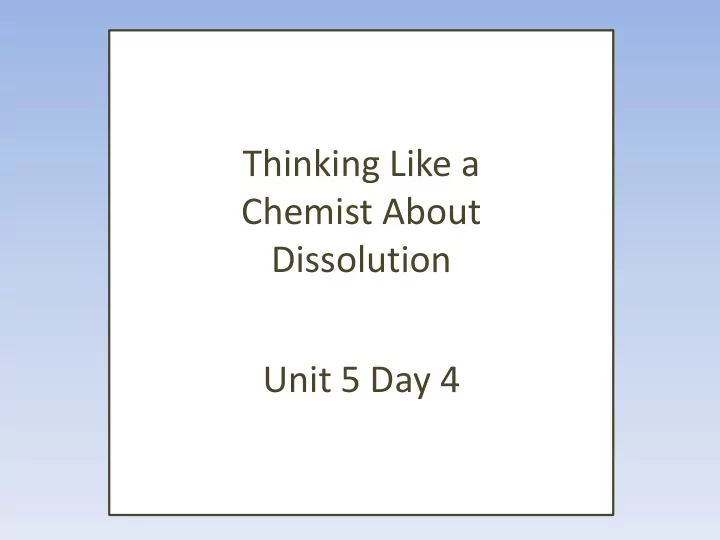

Thinking Like a Chemist About Dissolution Unit 5 Day 4
What are we going to learn today? Thinking Like a Chemist in the Context of the Dissolution Process. Macro Modeling Micro Modeling Energy of the change Modeling
Quiz: CLICKER QUESTION Which of the following has the highest vapor pressure? a) CH 3 OH b) CH 3 CH 2 OH c) CH 3 CH 2 CH 2 OH d) CH 3 CH 2 CH 2 CH 2 OH
Quiz: CLICKER QUESTION 3 At the triple point solid, liquid, and gas all have the same…. A. number of moles B. free energy C. volume D. density E. entropy
Solutions: Vocabulary Check! Solution = Solvent + Solute Solubility Dissolution Homogeneous Solution described by components and concentrations of those components! LM will instruct concentration units .
Get to work on the worksheet! MACROSCOPIC DESCRIPTION OF DISSOLUTION
Polling: Clicker Question A nice micro view of the dissolution of a(n): A. ionic solid B. molecular solid C. metallic solid D. covalent solid
Dissolution Demonstration Observations Sodium chloride in water Sucrose in water Ammonium nitrate in water
How do we think about this in terms of energy? ΔH solution 1. break solute – costs energy – Lattice Energy 2. form new solute-solvent interactions - give off energy – Solvation Energy ΔH solution = ΔH Lattice Energy + ΔH solvation
What did we learn just now? ΔH solution is hard to predict. Depends on energy needed to separate solute-solute and energy release when new solute- solvent attractions are formed. ΔH solution > 0 Typical Situation Solute-solvent interactions are weaker than solute-solute (and solvent-solvent) ΔH solution < 0 Unusual, but possible Solute-solvent interactions are stronger than solute-solute and solvent-solvent
Polling: Clicker Question What is going on with the entropy of dissolution for our example solutions? A. The entropy always increases. B. The entropy always decreases. C. It depends on the type of solid solute. D. It depends on the phase of the solute .
Entropy of Solution ΔS solution usually easy to predict Solutions typically have a higher entropy than the unmixed compounds Therefore ΔS solution > 0 For most cases Since entropy almost always favors mixing, the differences between different substances are the result of enthalpy (intermolecular forces)
Think about it Dissolution is? Work through this idea with an activity sheet CH302 Vanden Bout/LaBrake Spring 2012
POLLING CLICKER QUESTION A. ΔH is positive, ΔS is zero B. ΔH is zero, ΔS is positive C. ΔH is negative, ΔS is positive D. ΔH is negative, ΔS is zero
POLLING CLICKER QUESTION 7 How can you explain the spontaneous dissolution of the endothermic solution? A. It must be entropically driven B. It must not really be endothermic C. It must only occur at very low temperatures, because the solution does get cold D. It must be driven by the change in enthalpy E. It must not be as soluble as endothermic solutions
What did we learn today? Micro modeling of the dissolution process – noted the difference between molecular solids and ionic solids. Energy modeling of the dissolution process – noted the changes in enthalpy (solute-solute interactions vs solute- solvent interactions). Energy modeling of the dissolution process - noted changes in entropy – typically depends on the phase of the solute (solid dissolving in liquid vs gas dissolving in liquid). Energy modeling of the dissolution process – predict based on sign of ΔG.
Learning Outcomes Describe the factors that favor the dissolution process in terms of the intermolecular forces and thermodynamics (enthalpies of solution, solvation, lattice energy, entropies of solution, free energy of solution) Describe how P (Henry’s Law) affects solubility of a gas. Define and perform calculations for common concentration units molarity, molality, and mole fraction.
IMPORTANT INFORMATION HW1, LM04, and LM07 due TODAY 11:45 AM Assigned: LM06 Solutions LM08 Henry’s Law NOTE: THIS CLASS HAS BEEN DESIGNED TO BE A “HYBRID” OR “BLENDED” STUDENT CENTERED LEARNING EXPERIENCE. THIS MEANS THAT SOME OF THE COURSE INFORMATION WILL BE PRESENTED IN A DIGITAL FORMAT ON THE WWW IN EITHER PRINT OR VIDEO FORMAT. SO LEARNING MODULE INDICATES NEW LEARNING. HOMEWORK INDICATES PRACTICING CONCEPTS/PROBLEM SOLVING THAT HAS BEEN FIRST INTRODUCED EITHER IN CLASS, ON THE WEBSITE OR IN A LEARNING MODULE.
Recommend
More recommend